
The ultimate collectors’ edition of the classic 1960s strip The Daleks is on its way from Doctor Who Magazine.
First published in TV Century 21 from 1965 to 1967, “The Daleks” was devised by Terry Nation and, it is widely asserted, largely written by Doctor Who’s first story editor David Whitaker.
For this collectors’ edition, all 104 instalments have been digitally restored – the vast majority from the original artwork.

The bookazine also includes new features about the writers, illustrators and publishers who created “The Daleks”, including a detailed interview with one of its artists, Ron Turner; and a behind the scenes insight into the work that went into the presenting the pages in their best light.
Editor Marcus Hearn says: “This is the fulfilment of a long-held ambition. I loved this strip as a child and now – having seen the stunning restoration by DWM art editor Peri Godbold and her team – I admire it even more. You can’t really say ‘The Daleks’ has been restored to its former glory, because I think it now looks better than it’s ever looked before.”
• The Daleks is on sale at WH Smith, selected supermarkets and online at store.panini.co.uk from Wednesday 11th November priced £9.99 (UK) | ISBN 9781846532771 | Direct Link
• It’s also available as a digital edition, priced £8.99, from pocketmags.com
• You can order The Daleks from ForbiddenPlanet.com here – on sale in store from 18th November 2020 (Affiliate Link)
• Online single issue and subscription site Newsstand offers The Daleks Bookazine here – but as of Saturday 14th November 2020, note the “Request this issue” button, suggesting they too might be out of stock
• Diamond will be carrying The Daleks for US Who fans. The US cover price is $19.99
QUESTIONS FANS HAVE ASKED…
This section – and some of the article above – was last updated on 18th November 2020 to reflect comments made as to the authorship of the strip
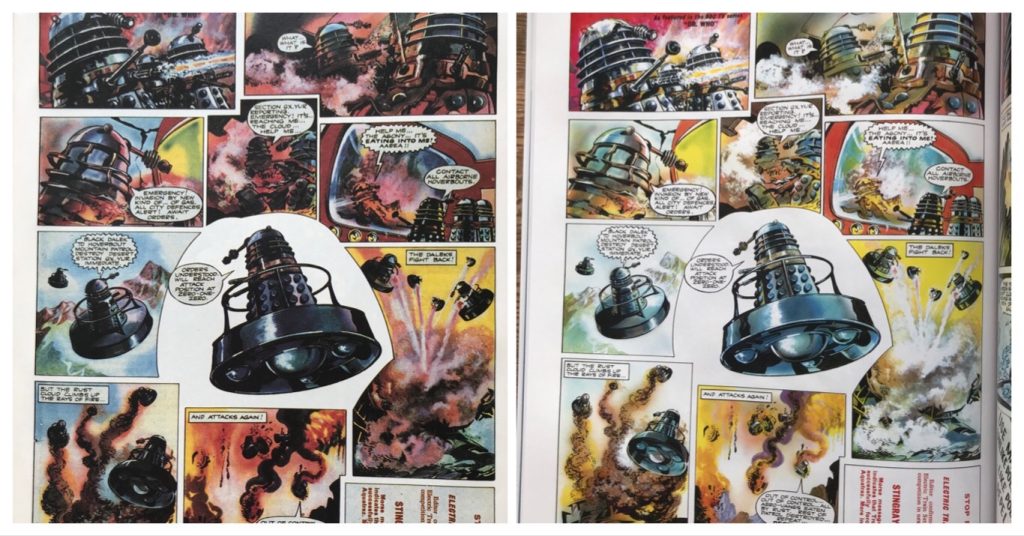
Which strips feature in this Bookazine from Doctor Who Magazine?
The Daleks presents all 104 original “The Daleks” strips, later reprinted variously as “The Dalek Tapes” and The Dalek Chronicles, first published in the TV Century 21 between 1965 and 1967. The stories detailed the history of the Daleks from their creation to their discovery of Earth.
The writers of “The Daleks” were, in alphabetical order, Angus Allan, Alan Fennell, Terry Nation and David Whitaker. TV Century 21 editor Alan Fennell told author Simon Archer that he worked alongside Terry Nation at the beginning, so can be considered a co-writer.
It is widely believed that David Whitaker wrote the majority of the strip, although this claim is contested, as you will see in comments to this article below from writer Alan Stevens, noting an alleged dispute between Nation and Whitaker, a claim made by Paul Fishman, son of Jack Fishman, the man who came up with the idea of publishing books about the Daleks in 1964, interviewed in Vworp Vworp Issue Three.
The artists on the strip were, in alphabetical order, Eric Eden, Richard Jennings and Ron Turner.
The Daleks does not include the continuation of “The Daleks” published in Doctor Who Magazine in the story “Return of the Elders” in the 1990s, written by John Lawrence and drawn by Ron Turner, or “Deadline to Doomsday” from the fanzine Vworp Vworp Issue Three, also written by John Lawrence, the first two pages drawn by Ron Turner and continued by Lee Sullivan, coloured by Charlie Kirchoff. The focus of this collection is entirely on the original 104-page strip published in the 1960s.

What size is it?
It’s a Bookazine – magazine format.
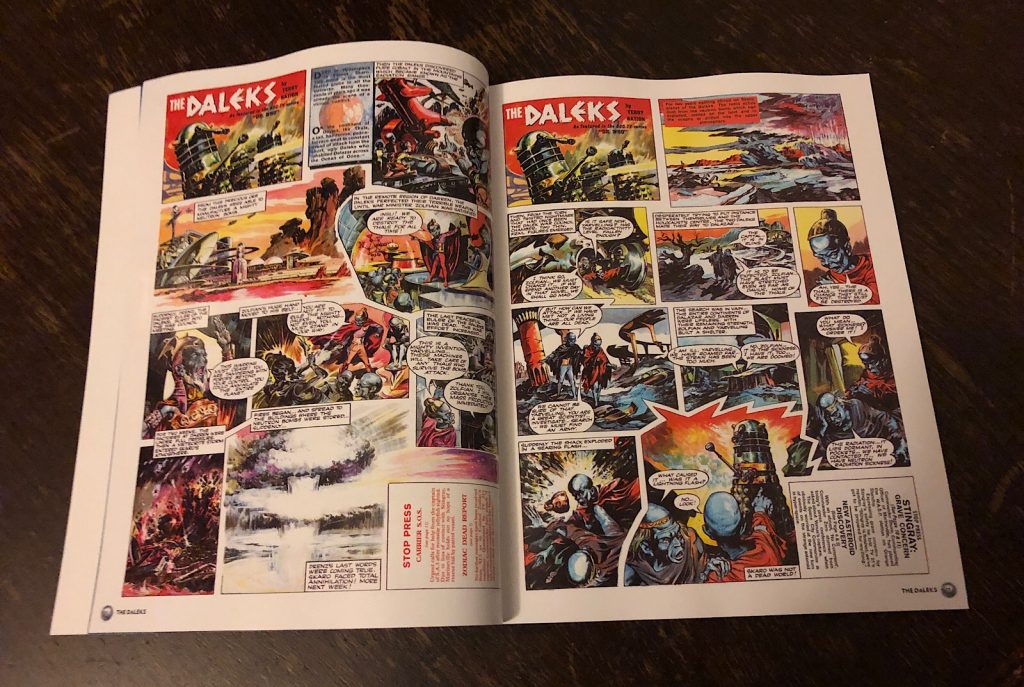
Is The Daleks included in my Doctor Who Magazine subscription?
No, as this is a Bookazine, not a Special. The next DWM Special is out mid December.
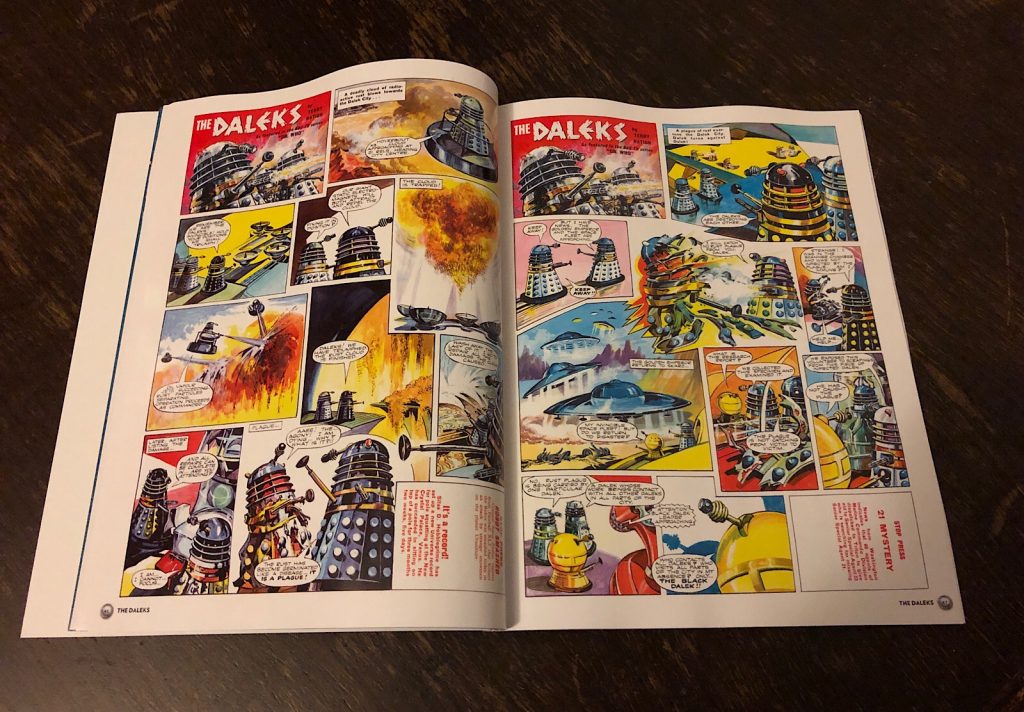
What else is in the Bookazine?
Also included are a feature on the origins of “The Daleks” strip for TV Century 21, written by Marcus Hearn, and an extended interview with artist Ron Turner; and a one page feature on the restoration work carried out to reproduce the strips, sourced from original art boards and pages of TV Century 21 by Peri Godbold.
The Origins of “The Daleks” Story Titles
Paul Scoones, author of The Comic Strip Companion: the Unofficial and Unauthorised Guide to Doctor Who in Comics, notes the 104 episodes of the TV Century 21 strip were simply titled “The Daleks”, with no story titles provided. There were no subtitles or “Next Time” captions to offer a clue as to what these might have been called (if indeed the stories even originally had titles).
The names by which we now commonly refer to the stories can be traced to the late 1970s and 1980. “The Menace of the Monstrons” and “The Rogue Planet” first appeared on reprints in Terry Nation’s Dalek Annuals (1977 and 1978 respectively).
The first three stories (“Genesis of Evil”, “Power Play” and “Duel of the Daleks”) were so named when they were reprinted as “The Dalek Tapes” in Doctor Who Weekly in 1980.
The remaining story titles all appeared in an article by Doctor Who comics historian J. Jeremy Bentham, called “TV Century 21; The Dalek Years” that appeared in a fanzine called Gallifrey in August 1980. Bentham seems to have invented these titles.
(Writer Alan Stevens notes that Jeremy Bentham has said he devised the title “Genesis of Evil”, although admits that Paul Neary coincidentally came up with the same title for “The Dalek Tapes’, prior to being handed a photocopy of Jeremy’s Gallifrey article. “Power Play” also comes from Bentham.
The set of titles was adopted by Jean-Marc Lofficier in 1991’s The Terrestrial Index and was also used in Doctor Who Classic Comics in 1992-93. However, the Jean Marc-Lofficier list is not entirely accurate to the titles Jeremy Bentham devised. For example, Bentham called “The Rogue Planet” “Rogue” as he misremembered the title that has appeared in the 1978 Dalek annual. Furthermore “Eve of War” was rendered “Eve of the War” by Bentham..
• Issues 1-3: Genesis of Evil
• Issues 4-10: Power Play
• Issues 11-17: Duel of the Daleks
• Issues 18-24: The Amaryll Challenge
• Issues 25-32: The Penta Ray Factor
• Issues 33-39: Plague of Death
• Issues 40-46: The Menace of the Monstrons
• Issues 47-51: Eve of War
• Issues 52-58: The Archives of Phryne
• Issues 59-62: The Rogue Planet
• Issues 63-69: Impasse
• Issues 70-75: The Terrorkon Harvest
• Issues 76-85: Legacy of Yesteryear
• Issues 86-89: Shadow of Humanity
• Issues 90-95: The Emissaries of Jevo
• Issues 96-104: The Road to Conflict
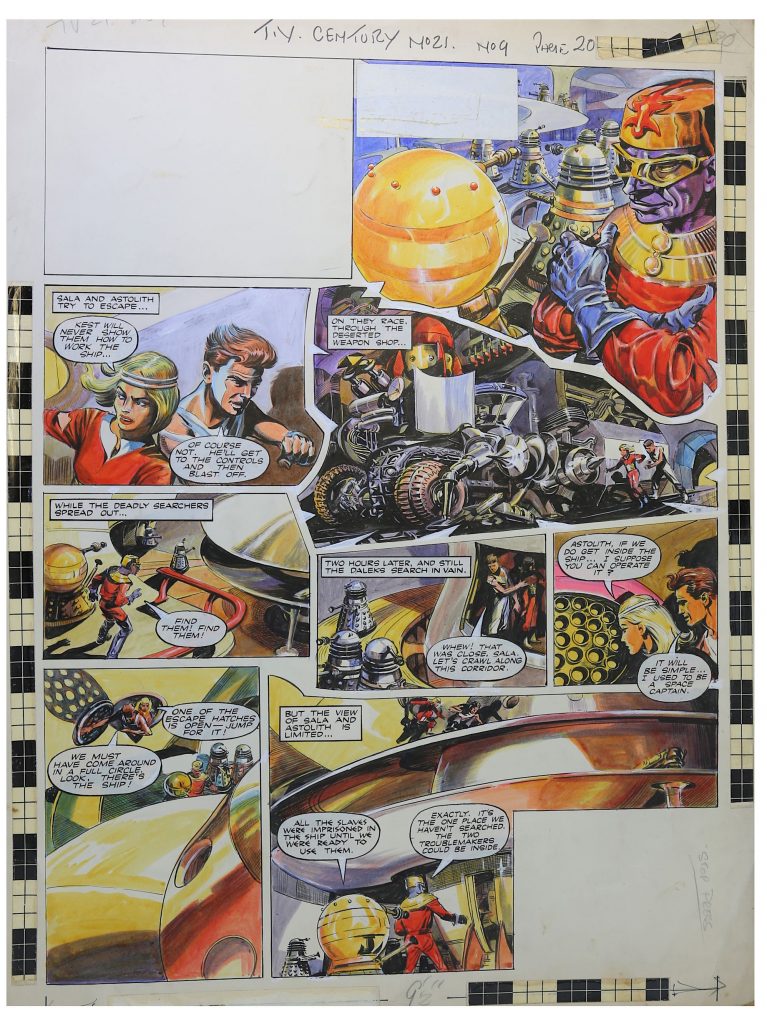
How many pages were reproduced from original boards?
Thanks to the generosity of many comic art collectors and Dalek fans, after an appeal on downthetubes and through various Facebook groups in part championed by myself, John Freeman, about three quarters of the original art boards were utilised in the making of this book. Some art eluded the editorial team due to COVID-19 restrictions – for example, a page held by the Cartoon Museum in London – and the vagaries of electronic communication, but given this strip was first published over 50 years ago, that so many boards have survived is remarkable.
Is this collection also available in hardback?
There are no plans for a hardback collection at this time. Official Doctor Who hardback books are at present only published by BBC Books.
Who drew the collection cover?
The art is by Doctor Who comic artist and TV series storyboard artist Mike Collins. “I kinda went over the top on it,” he admits, “because dammit, a project like that? You just gotta!”
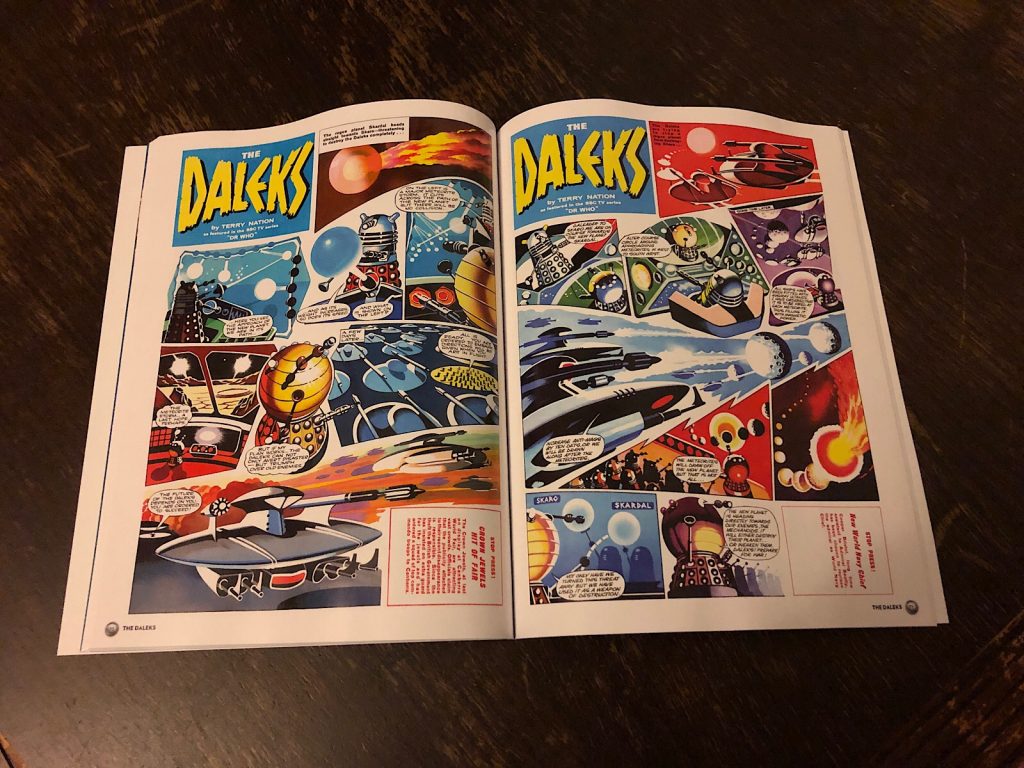
Who owns “The Daleks” strip?
Rights are complex. The original strip was produced in association with Daleks creator Terry Nation whose estate owns the Daleks 50/50 with the BBC as part of informal agreement, so a joint agreement to publish the strips is required.
In addition, the TV Century 21 brand is owned by Rebellion Publishing Ltd., publishers of 2000AD, necessitating their permits feature any TV Century 21 elements in any reprint. (If you’re curious about who owns what British classic comic characters, check out this page on downthetubes).
Are there any plans to reprint the Dalek annual comic strips, stories and other material?
Not that we are aware of at this time, although the search for “The Daleks” boards has unearthed some surviving art for those, too.
Are there any plans for a continuation of “The Daleks”, as proposed by John Freeman in the 1990s?
This writer welcomes approaches from genuinely interested publishers!
• The Daleks is on sale at WH Smith, selected supermarkets and online at store.panini.co.uk from Wednesday 11th November priced £9.99 (UK) | ISBN 9781846532771 | Direct Link
• You can order The Daleks from ForbiddenPlanet.com here – on sale in store from 18th November 2020 (Affiliate Link)
• Online single issue and subscription site Newsstand offers The Daleks Bookazine here – but as of Saturday 14th November 2020, note the “Request this issue” button, suggesting they too might be out of stock
• It’s also available as a digital edition, priced £8.99, from pocketmags.com
• Diamond will be carrying The Daleks for US Who fans. The US cover price is $19.99
With thanks to Paul Scoones for his notes on story titles and additional information on other aspects of the strip’s creation from Jeremy Bentham, Alan Stevens and Richard Whitaker made in comments below. Please note comments close automatically 14 days after initial publication
This article was last updated on 18th November 2020 to reflect comments made as to the authorship of the strip
The founder of downthetubes, which he established in 1998. John works as a comics and magazine editor, writer, and on promotional work for the Lakes International Comic Art Festival. He is currently editor of Star Trek Explorer, published by Titan – his third tour of duty on the title originally titled Star Trek Magazine.
Working in British comics publishing since the 1980s, his credits include editor of titles such as Doctor Who Magazine, Babylon 5 Magazine, and more. He also edited the comics anthology STRIP Magazine and edited several audio comics for ROK Comics. He has also edited several comic collections, including volumes of “Charley’s War” and “Dan Dare”.
He’s the writer of “Pilgrim: Secrets and Lies” for B7 Comics; “Crucible”, a creator-owned project with 2000AD artist Smuzz; and “Death Duty” and “Skow Dogs” with Dave Hailwood.
Categories: British Comics, British Comics - Collections, Doctor Who, downthetubes Comics News, downthetubes News, Other Worlds
 Panini teases Doctor Who “back up strips” collection
Panini teases Doctor Who “back up strips” collection  Doctor Who: Liberation of the Daleks comic collection set to materialise 23rd November – A Preview
Doctor Who: Liberation of the Daleks comic collection set to materialise 23rd November – A Preview  Anthony Lamb’s cover art for “Cybermen: The Ultimate Comic Strip Collection” revealed, print offered for direct orders
Anthony Lamb’s cover art for “Cybermen: The Ultimate Comic Strip Collection” revealed, print offered for direct orders  Doctor Who – The Fourth Doctor Anthology comics collection cover revealed
Doctor Who – The Fourth Doctor Anthology comics collection cover revealed
Great news… Loved the old collection (think it was part of the Classic Comics range). Good timing, worth the animated series around the corner.
Does the collection include Ron Turners wrap around cover from the last edition?
No
Bentham says he devised the title “Genesis of Evil”, although admits that Paul Neary coincidentally came up with the same title for The Dalek Tapes prior to being handed a photocopy of Bentham’s Gallifrey article.
“Power Play” does come from Bentham, however the Jean Marc-Lofficier list is not entirely accurate to the titles Bentham devised. For example, Bentham called “The Rogue Planet” “Rogue” as he misremembered the title that has appeared in the 1978 Dalek annual. Furthermore “Eve of War” was rendered “Eve of the War” by Bentham.
I think it’s also getting increasingly difficult to maintain the idea that the majority of The Daleks strip was written by Whitaker. Angus P Allan doesn’t recall Whitaker working on the strip at all and when he wrote a few installments himself for no additional payment, as he was on staff, Nation sent him a cheque for the work done. Why would Nation do that if Whitaker was primarily writing the strip?
It’s true that Alan Fennell recalls Whitaker working on the strip as does Whitaker’s wife, but Nation had a falling out with the writer in late 1965, so it’s more than likely that everything from The Archives of Phryne onward (with the exception of Angus’ above mentioned contribution) were written by Nation.
Indeed, I think it’s also highly likely that all the strips reprinted in the Dalek annuals and The Amazing World of Doctor Who, were also by Nation.
That’s very interesting, thanks Alan! Paul Scoones very kindly provide the information he gathered on the origins of the story names for this article. Thanks for additional information. The behind the scenes information on the writing of the strips is also interesting. I think we have a definitive list above, thanks to various researchers now, including yourself, Marcus Hearn and others.
It’s such a shame, not to say exceedingly tiresome, that Panini cling to their UK-sales only policy.
While this may be carried by Diamond in the US (at a considerable price hike), it doesn’t massively help those of us living in Europe but outside of the UK. While I appreciate licensing issues can be tricky, this publication (for example) is incredibly niche and unlikely to be picked up by European publishers (such as, uh… Panini…).
Oh well, off to get scalped by eBay, I guess…
In his book The Comic Strip Companion Paul Scoones lists the episodes as being primarily known as:
• Issues 1-3: Genesis of Evil (Bentham/Neary)
• Issues 4-10: Power Play (Bentham)
• Issues 11-17: Duel of the Daleks (although it was called Dalek Duel when first reprinted in the Doctor Who Holiday Special back in 1973, with this being the title Bentham used, however, The Dalek Tapes called it Duel of the Daleks!)
• Issues 18-24: The Amaryll Challenge (This is a Bentham title, whereas the Dalek Tapes called it Out into Space!)
• Issues 25-32: The Pentaray Factor (The Dalek Tapes called it The Penta Ray Factor, although really it should be called The Envoys of Evil, as that’s the title given in Terry Nation’s Dalek Annual 1977. Bentham didn’t buy the book at the time so was unaware of this)
• Issues 33-39: Plague of Death (Bentham title. The Dalek Tapes called it The Plague of Death)
• Issues 40-46: The Menace of the Monstrons (which comes from the Daleks Annual 1977 and was also used in The Dalek Tapes, whereas Bentham called it Attack of the Monstrons)
• Issues 47-51: Eve of the War (Bentham title. From this point the DWM reprints stopped attributing names to the stories. The Amazing World of Doctor Who called it “A Fresh Start”)
• Issues 52-58: The Archives of Phryne (Bentham title. The Dalek Annual 1977 called it The Quest)
• Issues 59-62: The Rogue Planet (Jean Marc-Lofficier actually called it Rogue Planet)
• Issues 63-69: Impasse (Another Bentham title. The Dalek Annual 1978 called it Collision Course!)
• Issues 70-75: The Terrorkon Harvest (Bentham)
• Issues 76-85: Legacy of Yesteryear (Bentham)
• Issues 86-89: Shadow of Humanity (Bentham)
• Issues 90-95: The Emissaries of Jevo (Bentham)
• Issues 96-104: Road to Conflict (Bentham, however, Classic Comics added “The”)
One other thing. There is no copyright divide between “characters” and “design. Instead the Nation Estate has an informal gentlemen’s agreement with the BBC that cut the ownership of the Daleks right down the middle, 50/50. This was revealed during the Court Case that arose over The Dalek Survival Guide, published by BBC Worldwide, and was claimed to infringe the copyright of JHP Limited, whose predecessor in title, was Souvenir Press Limited.
I so agree with you. I’m in Australia and would loved to have bought this?
“The writers of “The Daleks” were, in alphabetical order, Angus Allan, Alan Fennell, Terry Nation and David Whitaker. TV Century 21 editor Alan Fennell told author Simon Archer that he worked alongside Terry Nation at the beginning, so can be considered co-writer. David Whitaker wrote the majority of the strip.”
There is no evidence that “David Whitaker wrote the majority of the strip.” If Nation and Whitaker fell out in late 1965, to the extent where Nation punched Whitaker in the nose, and did not involved him with The Daleks Outer Space Book, or any of the subsiquent 1970s annuals, then it seems very unlikely that Whitaker was resonsible for the scripting of The Daleks strips printed between 15th January 1966 and 14th January 1967?. That’s eight stories out of sixteen!
What is the source of the information of this fall out, please?